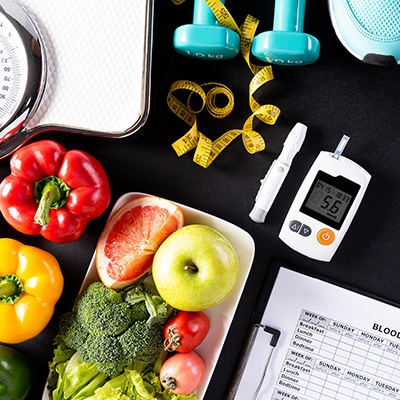Vitality eNews Sign Up
Receive the Summa Health eNewsletter for the latest health tips, advice and updates.
4 Ways to Balance Your Blood Sugar - No Prescription Required!
Posted December 05, 2022 by Andrew Chema, M.D.

Balancing blood sugar isn’t only for people with diabetes. Lowering blood sugar can help prevent a diagnosis of Type 2 diabetes.
Diabetes is a growing problem in this country. The American Diabetes Association (ADA) estimates almost half of Americans battle high blood sugar on a daily basis. According to the ADA, about 11 percent of Americans have diabetes, while another nearly 35 percent have prediabetes. People with high blood sugar, known as hyperglycemia, are at an increased risk of heart disease, stroke and other serious complications.
Your body manages blood sugar levels by producing insulin, a hormone that stimulates cells to use glucose (sugar) in the blood. But when cells are consistently exposed to high levels of insulin, they become less sensitive to its effects, resulting in insulin resistance or prediabetes.
While health conditions and genetics can cause high blood sugar, daily health habits also can play a major role. Poor diet, sedentary lifestyles and chronic stress can cause blood sugar and insulin levels to be higher than normal, which can lead to insulin resistance.
Summa Heath shares 4 lifestyle changes you can incorporate to balance your blood sugar — no prescription required! — and help reverse the effects of insulin resistance and lower your risk for Type 2 diabetes, even reverse a diagnosis.
1. Maintain a balanced diet
A healthy diet and portion control are very important in balancing blood sugar.Carbohydrates, more so than proteins and fats, cause blood sugar to spike after eating them because the body breaks down carbs into glucose. That doesn’t mean you can’t eat carbs, you just have to limit how much you eat. The amount you can have and keep blood sugar balanced depends on your age, weight and activity level. The ADA states a good rule of thumb is to limit your carbs to 25 percent of each meal.
It’s also key to eat at regular intervals throughout the day and never skip meals to prevent sharp highs and lows.
To help balance blood sugar — and support weight loss, too — stick to a healthy diet that includes:
- Limited carbohydrates. The ones you do eat should be whole foods, instead of processed carbs. For example, choose whole grains, brown rice, sweet potatoes and berries, while limiting processed breads, pastas and crackers.
- Healthy, lean proteins, such as chicken and turkey, fish, eggs and beans.
- Healthy fats, such as omega-3 fatty acids, which can be found in salmon, tuna fish, walnuts and soybeans, instead of saturated fats found in butter, high-fat meats and dairy products.
- Plenty of water, which helps flush glucose out of the body. Avoid sugary drinks, such as soda, energy drinks and juice.
- Lots of fresh fruits and vegetables, which not only are packed full of vital nutrients, but also fiber. Fiber can slow carb digestion to help balance blood sugar, and it also plays a role in weight management.
2. Exercise regularly
Exercise is beneficial for everyone’s overall health to reduce stress, keep a strong heart and manage weight. But, it’s also vital in balancing blood sugar because the body uses more sugar for energy.
The ADA recommends doing cardio exercises at moderate intensity for 30 minutes a day, working up to five times a week, to significantly benefit insulin regulation and blood sugar levels. Brisk walking, running, biking, strength training and swimming are good choices — and even dancing, gardening or playing your favorite sport.
3. Reduce stress
Chronic stress can lead to higher than normal blood sugar. When you’re stressed, the body releases higher levels of cortisol, the stress hormone that can increase your blood sugar.Getting plenty of sleep and incorporating stress-relieving techniques, such as yoga, meditation, exercise and talk therapy, are key to keeping your stress in check. On the flip side, be sure to avoid coping mechanisms, such as overeating and drinking alcohol, which can negatively impact your blood sugar.
4. Quit smoking
Nicotine raises blood sugar and smoking causes inflammation in the body, which also can raise blood sugar. It’s a lose-lose situation. In fact, smokers are at a 30 to 40 percent higher risk than nonsmokers for developing Type 2 diabetes, according to the U.S. Centers for Disease Control and Prevention.
Talk to your doctor to help you quit smoking or call 1-800-Quit-Now. It’s never too late.No one said making — and sticking to — these lifestyle changes is easy. If you’re struggling to incorporate these healthy habits, ask your doctor or dietitian for help. They can help you individualize an eating plan, make adjustments in your daily routine and set realistic goals. Even small changes can make a huge difference.
If your blood sugar remains high after several months of incorporating healthy habits, talk to your doctor or contact a Summa Health primary care provider. Call 800.237.8662 to schedule an appointment.